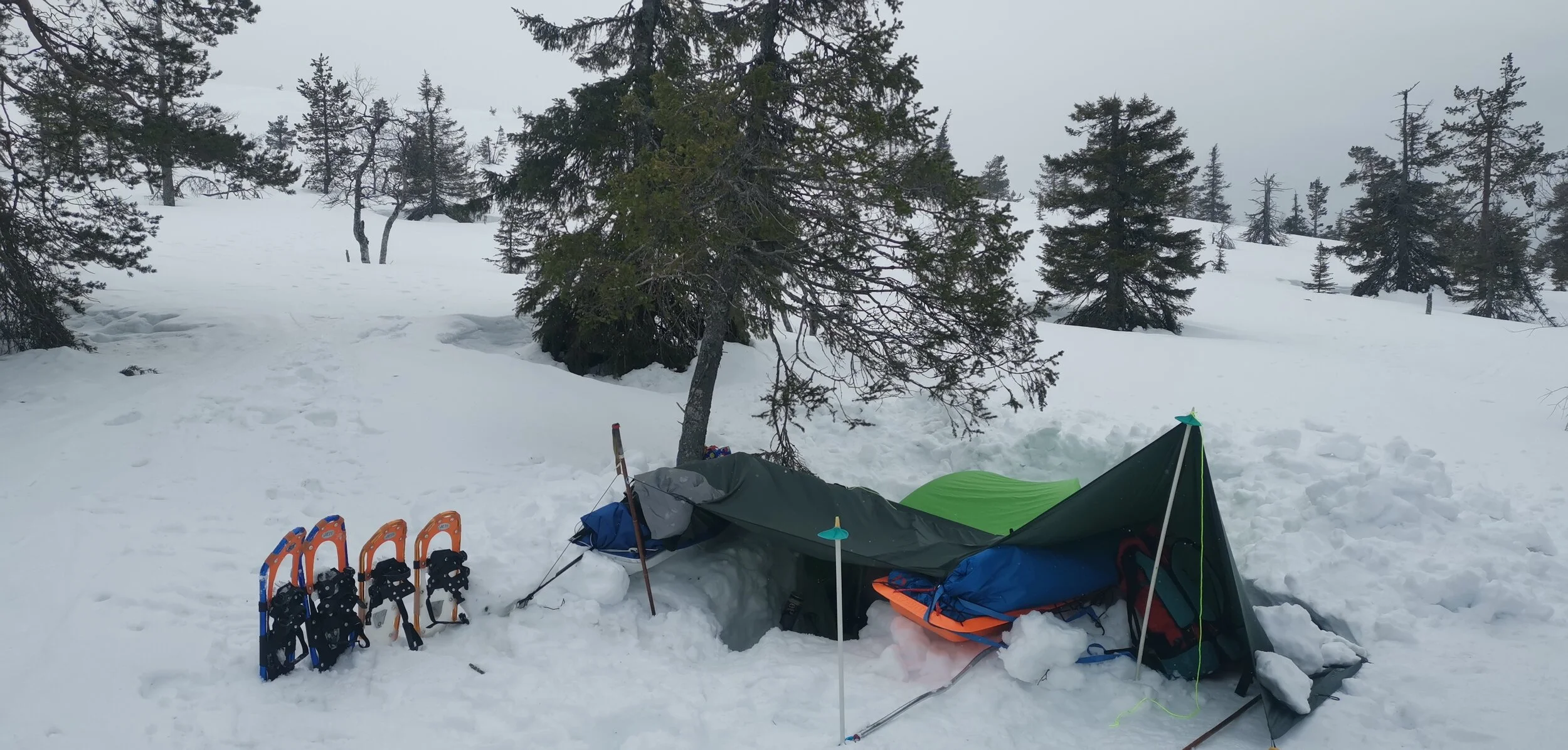Winter trekking in Lapland
White frozen crystals glisten in the sunlight as they float blissfully in the air. There’s 50cm of snow on the ground and the temperature is around 0°C, but the long sunny days speak of spring in the winter landscape. Despite the beauty, a cold shiver runs through me, are we really going to spend the next week outside in this winter landscape?
It takes a lot of planning and organising when heading out for a winter trek. You have to come up with a route plan, think of possible exit points, check for weather updates, buy and prepare all the food, pack and borrow/rent all the necessary equipment etc. Luckily I enjoy the planning and organising, which is an essential part of a guide’s job. The more you plan and prepare, the easier you can respond to the unexpected events that will occur during the trek.
The snow offers many possibilities for modes of trekking: skis, snowshoes, fatbikes, snowkiting etc; and in most cases you pull your equipment in a sledge behind you. We chose to go with skis this time because it’s easier to explore the unbeaten paths with skis even when your average pace is 1.5-2 km per hour. With the slow pace, you definitely have time to appreciate the view. This year we headed for a 6-day winter trek in western Lapland at Ylläs-Pallas National park. The national park has old forests, lakes and rivers, and fells that dominate the scenery; it has a lot to offer so no wonder it’s the most visited national park in Finland.
We camped at three different locations; when trekking in a national park you are allowed to sleep only at campsites. This suited us fine as the campsites had nice fireplaces and wilderness huts to warm our toes in the evening and dry some of our moist clothes. When arriving at the campsite you have to beat a place for the tent in the thick snow or dig a sheltering hole in the snow. We slept in our Tentsile tree tent with its ground conversion kit and sheltered our sledges and equipment underneath a tarp. It’s important to have a well-ventilated tent as you want to prevent moisture getting into your gear. One of my favourite parts about winter camping is building your own kitchen, shelves, and benches from snow; it brings back memories of all the great snow castles we built as kids.
In Finland there are many amazing little wilderness huts scattered around the country. These huts are free to use by anyone for a few nights, and they are managed by Finland’s agency for Parks and Wildlife. However, it’s common courtesy to put in some effort in the upkeeping when you’re visiting one. We chopped some wood, shovelled snow from the fireplaces, cleared the ashes, sweeped the floors, and collected rubbish. The rule of thumb is to leave the place cleaner than it was before your visit.
Being outside nearly 24/7 you need energy to keep yourself warm and active. We had a lot of food with us, which proved to be tasty and fast to cook with our winter gas trail stove. Our menu consisted of: morning porridge with spices and instant coffee; instant noodles with soy granules for lunch; afternoon bite of four different rye bread sandwiches per person: 1x dried tomato-spinach-tofu, 1x tomato puree-horsebean mix-spinach, 2x peanut butter-cloudberry jam; for dinner we had instant rice with soy slices and cranberries with an Indian spice mix. All day long we snacked on: nut mixes with dried fruit and hot blackcurrant juice. And as a treat on the last night we had pringles crisps and chocolate.
As you know water freezes below 0°C, so you have to keep a close eye on your water bottles and preferably store the water in a thermos. We used around 4L of water per person each day. In the evenings we melted snow by the campfire or drank the water from clear water streams and lakes.
There’s so much I’d like to say about winter trekking, its definitely an experience you will remember. In many ways it’s tougher on your mind and body than trekking in summer, having to constantly balance yourself with the cold harsh environment. Nevertheless, it helps you shift your focus on the essentials of life, and you become more present in life’s everyday moments. We turned off our phones and zoned out of the virtual world for those days, and even though it felt strange at the start it did so much good for our racing minds.
Spending time in nature has been proven to relax people, and even though winter trekking doesn’t feel stress free at times, we felt revived in the end. We hope you feel inspired to venture out into nature whatever the weather or season. We definitely recommend a guide or deliberate practise before embarking on your first winter trek, but once you get out there you will be amazed. See you out there next winter!
“Sometimes it’s okay to sit peacefully for hours looking at the view in front of you, for no particular reason.”























